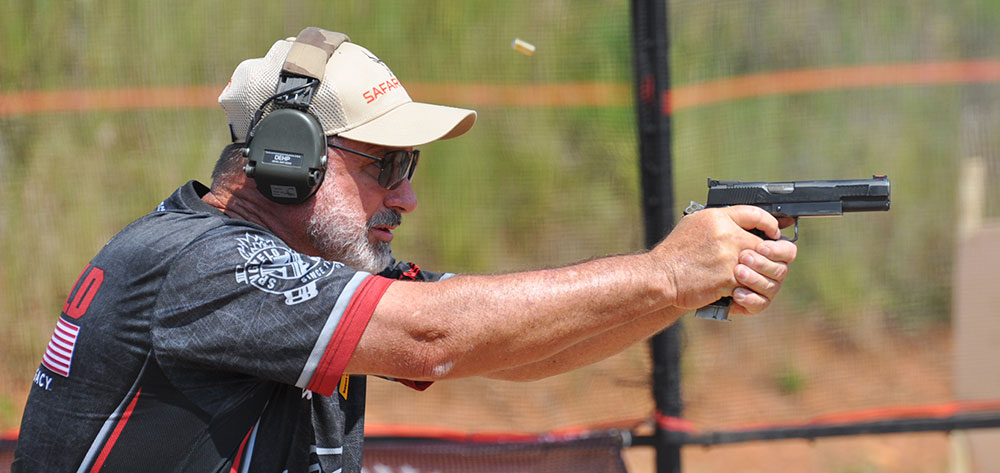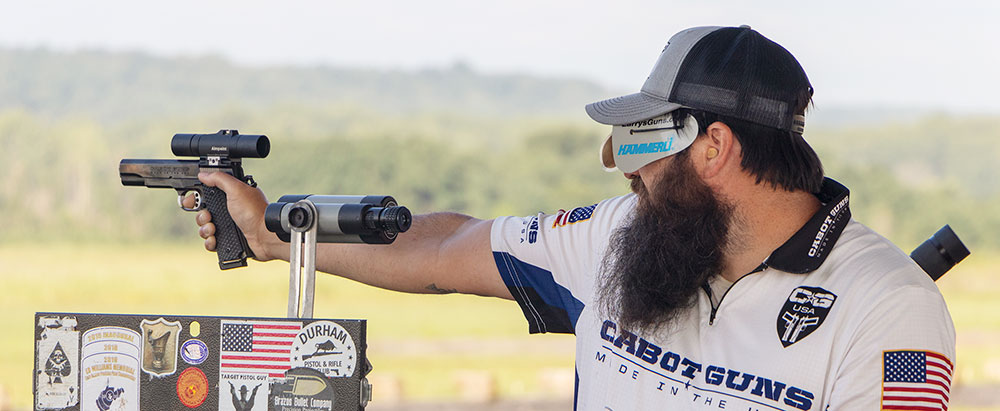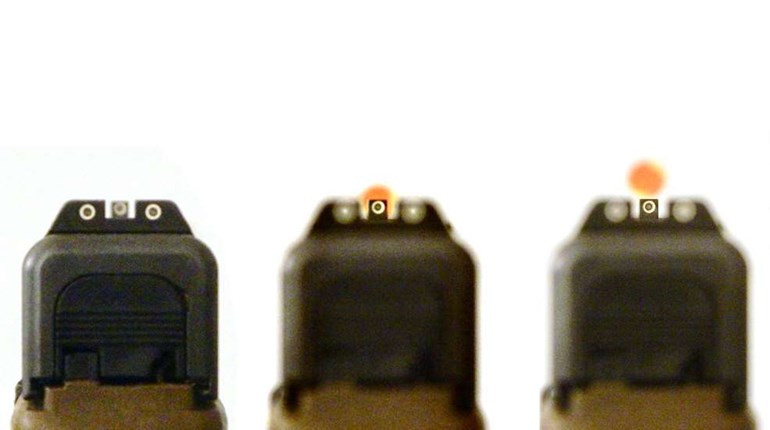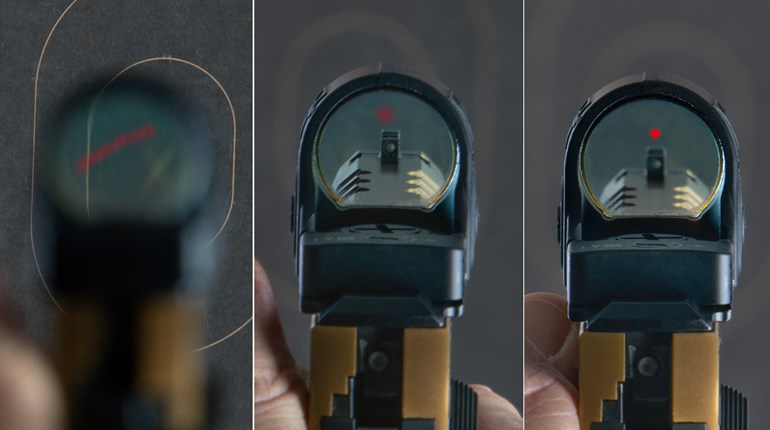
Renowned, multiple-time world-champion competitive shooter Rob Leatham shares his hard-earned wisdom: “Speed is no more inaccurate than slow is accurate.” If this is true, then why do some shooting instructors tell you to “slow down and get the hit,” when in fact going slow has nothing to do with accuracy? The answer is found in developing your fire-control skills to shave valuable time across your entire shooting platform.
Leatham’s adage happens to be true as demonstrated by countless grandmasters across the globe, including him. Clocking the impressively accurate round-placement speeds of a legitimate grandmaster shooter fully supports the veracity of his claim.
Given this premise, how does one then dispel the “slow is more accurate” fallacy? The answer is to shoot more accurately, faster. Easier said than done, right? Although you may have a sound understanding of this concept mentally and perhaps the requisite mechanical skills, pulling it off more than 85 percent of the time requires the on-demand consistency of a master-level shooter.
How can you attain such an elevated level of repeatable performance? Leatham will be the first to say that “what you’re trying to do is exceptionally difficult.” It’s not something everyone can do, because if it was, then everyone would be able to hammer five rounds into a fist-size group in an A-box at the 25-yard line from the holster in less than 4 seconds on their first day at the range.
Rather than approaching this seemingly paradoxical dichotomy in terms of a speed-accuracy relationship, let’s examine it from a speed-control relationship.
Look at any professional athlete like a hockey, basketball or Major League Baseball player performing at the highest levels. They always move faster and are more confident than the non-professional, make fewer mistakes and make it look so easy. Since it’s their full-time job, they train extensively to move quicker, make fewer mistakes and it doesn’t look like they’re working as hard at it, because they are not.
Analysis of the performance sub-components of the professional athlete to the fundamentals of speed (going fast), success (repeatability) and confidence (ease of movement) will allow us to apply these same sub-components to further develop our own on-demand shooting performance.
Speed, repeatability and ease-of-movement are quite arguably the most prominent elements of any on-demand performance. However, before delving deeper into each of these particulars, let’s take a quick glance from the outside looking in.
Tension
Any shooter seeking to shoot well must be made aware of one of the greatest threats to repeatable on-demand performance—tension.
The insightful words “tension is the enemy of performance” highlight a profound truth—that often, our own strained attempts at perfection undermine our abilities. This maxim transcends the shooting domain, finding application from artistic expression to athletic prowess. It serves as a critical reminder that when pressure mounts and stress tightens its grip, we rarely perform at our peak.
The seasoned musician knows the frustrations of overthinking intricate passages. The harder they try to force the notes from memory, the more the music eludes them. Yet, take a step back, clear the tension from one’s mind and muscle, and suddenly the melodies flow effortlessly once more. The tendency to bear down and “grip too tight” is in fact detrimental, revealing tension as the nemesis of performance.
So, too, does the star quarterback lose his/her innate rhythm and finesse in the closing minutes of a big game, the immense pressure causing them to “choke.” But, in calmer practices he/she threads perfect spirals through the air. For them as well, tension proves the enemy of achievement. Only by learning to quiet the strain and stress, to stay fluid and focused in the moment, can he hope to overcome it. Time and again, we hamper the very abilities we long to demonstrate by our own taut anxiety.
As its snares grow tighter, tension stifles the mechanical process, blunts the reflexes and blocks the mental process which could otherwise illuminate our performance and help transform possibility into reality. Yet, if we step back from consciously controlling each action and outcome, relaxing into simply letting go, talent is permitted to manifest.
Much as we may try to compel results through strained exertion, we achieve our potential only when tension’s talons retract from our mind and body. Trusting in meticulous preparation, then resting on the assurance of our capabilities allows us to rise to challenges unencumbered. Performing under pressure is a fine art. But, its secret lies in the ability to find space, allow flow and let go of tension’s insidious tricks. When we unravel such bonds, we obtain the freedom to turn possibility into mastery.
Speed
Speed is nothing more than efficiency, expressed. Therefore, efficiency is paramount, whether constructing an engine or working on reducing the overall time of your draw stroke. At its core, efficiency represents the ratio between the effective output garnered from a system and the resources invested in it. More specifically, when applied to gun handling and marksmanship, the measurement of efficiency is speed.
An efficient machine converts energy into maximum useful work. An efficient thinker arrives at optimal solutions with minimal wasted mental effort. Efficiency thus denotes the crucial balancing of a process’ costs against its ultimate returns.
For pioneering engineers, maximizing mechanical efficiency meant minimizing energy loss to friction, heat and other leaks that divert output. More incoming power could instead be channeled directly into rotational force, thrust or torque. This principle enabled engines from steam locomotives to internal-combustion motors to generate unprecedented speeds, power and durability while using less fuel.

Such gains compounded over generations of tinkering and testing. But, the essence remained that efficiency’s ideal is generating the highest kinetic return-per-unit of energy input. Where loss was minimized, productive output was maximized. This ethos made the entire modern world of mechanized speed possible.
Efficiency applied to shooting is no different. Speed is nothing more than the product of no excessive motion or wasted energy.
Whether pistons in an engine or a pistol presentation from concealment, the overarching lesson remains that efficiency enables aspirations to become reality. It is the linchpin that cements potential into achievement. By mastering efficiency’s nuances, we can step out of our comfort zone and develop the skills capable of conquering new and attainable goals.
Fast runners, fast car drivers and fast shooters all share one thing in common: efficiency. The least amount of movement creates the least amount of input into the gun. Adding input into the gun causes any number of undesired events which contribute to cascading series of undesired events (inefficiencies), all of which cost valuable time.
Excessive input adds to muzzle movement. The muzzle is perpetually moving as it is; you certainly don’t want to introduce even more instability. Any energy contributing to unnecessary movement is considered inefficient as that excessive movement—which already costs you time—must now be corrected, costing you even more time than if you didn’t need to make any corrections.
An illustration of efficiency might include an optimal magazine reload. No matter how quickly you want to move, if your magazine well is not in your workspace and you don’t have a straight-line movement from your mag pouch to the mag well, then you’re wasting space, movement and energy, all of which equate to inefficiency.
Efficiency might be described as presenting your handgun from the holster in such a manner as to come to your workspace employing only kinesthetic or proprioceptor alignment and then switch over to visual processing as you integrate your mechanical processing, including trigger manipulation.
Eventually your visual process in reading the situation, as soon as it presents itself, provides the green light to break the shot.
At the end of the day, speed is nothing more than an alluring shiny object for the amateur shooter to chase. Its only true function is as a measure of how long it took you to accomplish a task.
Success
As a shooter develops further skills in the art and science of shooting, something interesting happens. He/she begins shooting noticeably tighter groups at greater speeds, with fewer mistakes and with less wasted movement, all of which adds up to success—the second sub-component of repeatable on-demand performance.
The fewer your mistakes, the greater your success. Who doesn’t want greater success? Ironically, the path to success is paved with lessons learned from making mistakes. If you are not risking mistakes intentionally in your training, then you are not progressing.

We’ve all heard the phrase “You learn from your mistakes.” This adage rings true in all areas of life, but is especially relevant when it comes to training. Mistakes are not only unavoidable, but are also a critical part of the learning process. Making mistakes gives you valuable feedback, pushes you outside your comfort zone to gain new skills and can lead to insights and breakthroughs.
When you make a mistake, you receive direct evidence that you have more to learn in a particular area. Without making mistakes, you miss out on this valuable feedback needed for improvement. Mistakes point you toward weaknesses, gaps in understanding or flawed thinking. They show you directly where you need to focus your study or practice to shore up deficiencies in knowledge, skills or judgment. Rather than viewing mistakes as failures, embrace them as progress markers on the road to shooting mastery.
Staying within your comfort zone hinders your learning, while pushing beyond it accelerates progress. Attempting something new or challenging where you don’t feel confident about succeeding increases the chance you’ll make a mistake. But at the same time, this expands your abilities. As the old saying goes: “If you never fail, then you’re never pushing your limits.”
Mistakes test your composure and mental fortitude. They build grit and tenacity as you learn to accept errors without frustration or loss of self-confidence. Bouncing back from mistakes gives you practice emotionally coping with challenges as well as unforeseen setbacks.
Mistakes provide us with valuable feedback to target your learning, force you to expand your skills, build grit and resilience, cement comprehension through struggle while also inspiring flexibility and imagination. Rather than avoiding errors, embrace them for the learning opportunities they provide. The path to excellence is wrought with mistakes, missteps and failure. However, with the right mindset aimed at growth, you can leverage the pivotal role mistakes play in unlocking your true potential.
Confidence
Ease of movement, the third and final sub-component of on-demand performance, is confidence. When you are supremely confident about something you are exceptionally comfortable with it.
Stepping outside your comfort zone is pushing past your current skills envelope. Discovering your efficiencies by trial and error, you start to gain greater confidence in your abilities. Confidence is pressing the “I believe” button and ultimately trusting in those abilities. To the degree of self-trust is to the degree of mastery. If you don’t believe in yourself or trust in yourself then your mind wavers and struggles to break itself free from the ubiquitous shadow of doubt.
Ease of movement is an expression of confidence. The greater your familiarity and comfort with a skill, the greater your confidence.
The first step toward elite shooting performance is to eliminate tension from the equation altogether. Next is to know the difference between “going fast” and being efficient (no wasted movement). The measurement of efficiency is speed. How do you get faster and more accurate? Find your efficiency.
Integral to finding efficiency is success. The more you leverage your mistakes in training, the greater your successes (fewer and less egregious errors). Lastly, but certainly not least of the sub-components, confidence is built upon the bedrock of comfort.
At elite performance levels, the greater your efficiency, the less time it takes to accomplish the task at hand (speed); the less frequency and severity of your errors, the greater your accomplishments (success) and the greater your familiarity, the greater your comfort (confidence).
The fruition of such good habits as gaining efficiency, learning from your mistakes and building confidence is what brings all shooters to the stark realization that speed is no more inaccurate than slow is accurate.




































